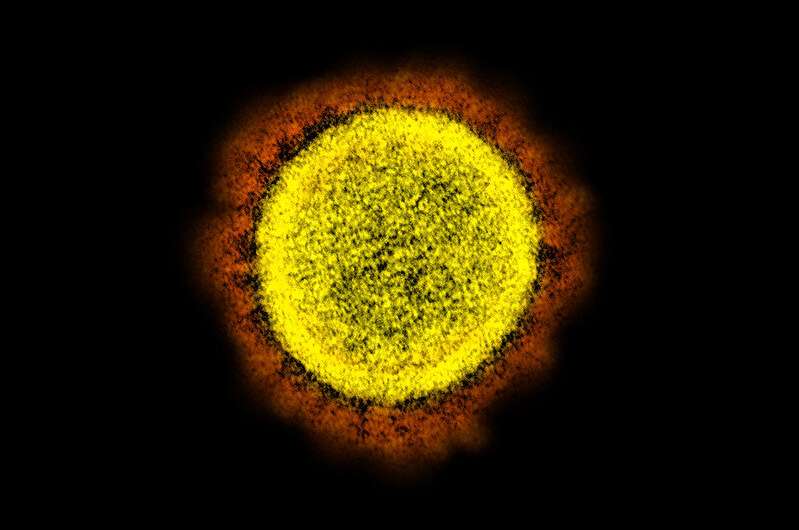Novel Coronavirus SARS-CoV-2 Transmission electron micrograph of SARS-CoV-2 virus particles, isolated from a patient. Image captured and color-enhanced at the NIAID Integrated Research Facility (IRF) in Fort Detrick, Maryland. Credit: National Institute of Allergy and Infectious Diseases, NIH
A team of UK investigators has shown that RNA copies recovered from surfaces are a poor indicator for determining the numbers of viable SARS-CoV-2 virus particles.
The research, published in Applied and Environmental Microbiology, a publication of the American Society for Microbiology, found that a common UK isolate of SARS-CoV-2 that may have initially contaminated surfaces in the general environment became undetectable within 48 hours. The isolate of SARS-CoV-2 remained viable for more than twice as long on hydrophobic surfaces as on hydrophilic surfaces.
The materials tested in the study were representative of those in personal protective equipment, as well as high hand-touch sites such as stainless steel.
An impediment to determining how long SARS-CoV-2 remains viable on different surfaces has been that in most cases, viable virus that has landed on surfaces is rarely detected, according to corresponding author Thomas Pottage, BSc, Senior Project Leader—Biosafety and Bioresponse, Public Health England, Porton Down, UK. However, many studies have used reverse transcription polymerase chain reaction (RT-PCR) successfully to detect viral RNA and use this as an indicator of how much of the virus was previously found on the surface.
Therefore, the investigators first sought to determine the relationship between initial quantities of viable virus, and subsequent RNA copy number on a contaminated surface, hoping that the latter could serve as a surrogate for the former. To test this, they contaminated surfaces of interest with artificially high concentrations of the virus in the laboratory. But there was no clear relationship between the numbers of RNA copies recovered over time to the number of viable virus particles in the initial inoculum. The investigators did observe that the numbers of virus particles decreased quite rapidly.
The relationship in levels of RNA and viable SARS-CoV-2 shows that in previous surface sampling studies where SARS-CoV-2 RNA was recovered, there were likely low concentrations of viable virus on those surfaces at the time of contamination, according to Pottage.
"This study estimates that the SARS-CoV-2 would survive less than two days on surfaces under normal environmental concentrations," said Pottage.
Conversely, artificially high concentrations of SARS-CoV-2 that were deliberately deposited on surgical mask material and stainless steel in a laboratory setting resulted in relatively lengthy persistence, with 99.9% reductions in viable virus taking place over 122 and 114 hours, respectively. Viability dropped the fastest on a polyester shirt, with a 99.9% reduction occurring over 2.5 hours.
"Our results show that the porous but hydrophobic surfaces of the surgical mask and Tyvek coverall produce similar decay rates when compared to the non-porous hydrophobic surfaces of stainless steel," with a reduction in numbers of virus particles of 99.999% over seven days, said the authors. Viable SARS-CoV-2 was recovered from these surface materials over longer periods of time compared to the porous, hydrophilic surfaces tested, cotton and woven polyester.
More information: Susan Paton et al, Persistence of SARS-CoV-2 virus and viral RNA in relation to surface type and contamination concentration, Applied and Environmental Microbiology (2021). DOI: 10.1128/AEM.00526-21
Journal information: Applied and Environmental Microbiology
Provided by American Society for Microbiology
























